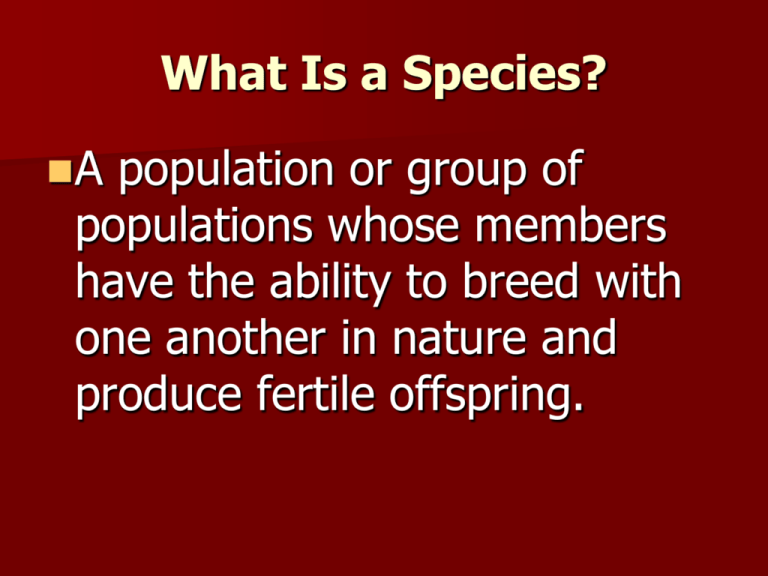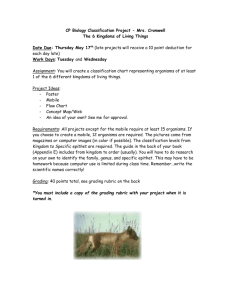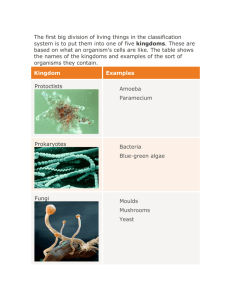Chapter 15
advertisement

What Is a Species? A population or group of populations whose members have the ability to breed with one another in nature and produce fertile offspring. Microevolution refers to change in the allele frequencies within a population. Macroevolution : These changes include: -the origin of different species, -the extinction of species, and -the evolution of major new features of living things, such as wings or flowers. Speciation The origin of new species is known as speciation Geographic Isolation and Speciation Geologic processes constantly change and rearrange Earth's features. This change can separate different populations of one species. Ex: A mountain range may gradually emerge, slowly splitting a population of organisms that cannot cross it. Separation of populations as a result of geographic change or dispersal to geographically isolated places is called geographic isolation. What Is Taxonomy? Classification of living things is called "Taxonomy." This is when scientists put organisms into groups when they have things in common. The first groups they use are the Kingdoms. There are five kingdoms -Animal Kingdom -Plant Kingdom -Fungi Kingdom -Protist Kingdom -Moneran Kingdom Now represented by 2 kingdoms Each Kingdom is then split into smaller groups, called Phyla. Each Phylum is split into smaller groups called Classes, Each Class is split into Orders, Each Order is split into Families, Each Family is split into Genera, Each Genus is split into Species. As each group is split into smaller groups, the organisms are more and more alike. A Five-Kingdom Scheme It places prokaryotes such as bacteria in the kingdom Monera. Organisms of the other four kingdoms all consist of eukaryotic cells. The kingdoms for plants, fungi, and animals consist of multicellular eukaryotes. The Linnaean System of Classification The system of classification most widely used in biology dates back to Swedish botanist Carolus Linnaeus (1707–1778). The system has two main characteristics— a two-part Latin name for each species and a hierarchy, or ordering, of species into broader and broader groups. Scientists from around the world agreed to use the ancient language of Latin to give organisms, and their groups, names. Sometimes a group will have a "Common Name" and a fancy, scientific Latin name. For example, there is a Family of frogs called "Ranidae" (Scientific Latin name). This Family's common English name is "Tree Frogs." Every Species gets a fancy scientific Latin name. A Bullfrog is also known as "Rana catesbeiana." A White-tailed Deer is known as "Odocoileus virginianus.“ A Monarch butterfly is known as "Danaus plexipus." One thing that makes it easier to understand all these names is to know that a Species always has a first and a last name The first name is also the name of the Genus group that Species is in. So the Monarch butterfly is known as Danaus plexipus and it is in the Danaus genus. Notice that the first name of a Species is always capitalized, while the second name is not. Species are classified into groups within groups. A diagram that reflects such hypotheses of evolutionary relationships has a branching pattern called a phylogenetic tree -The diagram's name comes from the word phylogeny, meaning "evolutionary history. Three Domains In the last decade, molecular data and cladistics have led to a reevaluation of the five-kingdom system. A three-domain system as one alternative to the five-kingdom system. A domain is a taxonomic category above the kingdom level. This newer scheme recognizes three basic groups: two domains of prokaryotes—the Bacteria and the Archaea—and one domain of eukaryotes, the Eukarya. The Bacteria and the Archaea differ in a number of way. What is most important to understand here is that classifying Earth's diverse species of life is a work in progress.









